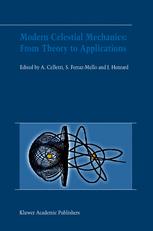

Most ebook files are in PDF format, so you can easily read them using various software such as Foxit Reader or directly on the Google Chrome browser.
Some ebook files are released by publishers in other formats such as .awz, .mobi, .epub, .fb2, etc. You may need to install specific software to read these formats on mobile/PC, such as Calibre.
Please read the tutorial at this link: https://ebookbell.com/faq
We offer FREE conversion to the popular formats you request; however, this may take some time. Therefore, right after payment, please email us, and we will try to provide the service as quickly as possible.
For some exceptional file formats or broken links (if any), please refrain from opening any disputes. Instead, email us first, and we will try to assist within a maximum of 6 hours.
EbookBell Team

0.0
0 reviewsAt the opening of the "Third Meeting on Celestial Mechanics - CELMEC III", strong sensations hit our minds. The conference (18-22 June 2001) was being held in Villa Mondragone, a beautiful complex of buildings and gardens located within the township of Monte Porzio Catone, on the hills surrounding Rome. A former papal residence, the building has been recently restored by the University of Rome "Tor Vergata" to host academic activities and events. The conference room is called "Salone degli Svizzeri": here, Gregory XIII, on February 24, 1582, gave its sanction to the reform of the Julian calendar and declared officially in use the calendar still adopted nowadays. The magnificent high walls and tall ceiling strongly resounded, giving to our voice a peculiar Vatican sound, which took us by surprise. May be - we thought - a distant echo of the very words of Gregory XIII proclaiming the modem calendar was still haunting the room. Around us, in the audience, many countries were represented, thus indicating that the idea of putting together the three "souls" of modem Celestial Mechanics - perturbation theories, solar and stellar system studies, spaceflight dynamic- had been successful. CELMEC III is in fact the latest of a series of meetings (the first two editions took place in 1993 and 1997 in L' Aquila, Italy) whose aim is to establish a common ground among people working in Celestial Mechanics, yet belonging to different institutions such as universities, astronomical observatories, research institutes, space agencies and industries.